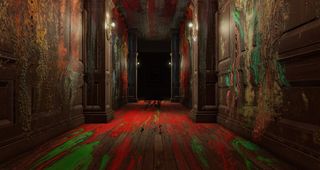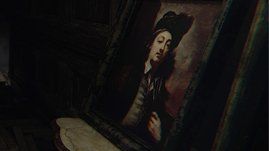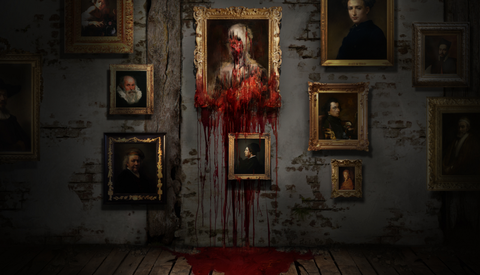GamesRadar+ Verdict
One of the best horror games ever made, this will scare you in incredibly clever ways and make you question everything you see.
Pros
- +
An excellent example of perfectly crafted horror.
- +
Devious and unsettling visual tricks constantly test your nerve.
- +
Dark pressing atmosphere that never lets go.
- +
Brilliantly paced progression and scares.
Cons
- -
Weirdly sluggish controls.
- -
Occasionally obtuse puzzles.
Why you can trust GamesRadar+
Layers of Fear has just been ported to Nintendo Switch as Layers of Fear: Legacy, so we've resurfaced our review of the original horror game for those who want to get scared witless while on the go.
Anything can make you jump. A loud noise and a sudden movement? That’s brute force horror and takes no real skill. Easy. Try it with a friend (maybe one you don’t like that much). However, to make you doubt yourself? To be left afraid because you can’t trust your own eyes any more? That’s a masterclass in evil and Layers of Fear is that masterclass.
Effectively, Layers of Fear plays like a Gothic PT, throwing in elements of things like The Shining and The Woman in Black. It’s a psychological horror experience that messes with your head in a far more disturbing way than any monster jumping out from behind a curtain (although that is an option here). The imagery is constantly unsettling: art with misshapen faces or monstrous forms, the worst creepy dolls, and an artist’s paints apparently claiming parts of a house in fat, sludgy blobs. Sound also worms its way under your skin, as whispering voices leak from the controller and a tense ambiance threatens you as you explore.
There are jump scares but where it really pushes into new ground, and secures a near groundbreaking status, is the way it wilfully abuses your senses. Things shift under your eye: the door you just came through might not be there when you turn round. Or the room will have changed when you look back. Pictures twist into horrifying images just on the edges of your vision, as nightmarish shapes and forms slide over the real world while your gaze is directed elsewhere. The effect erodes your faith in just simply being able to trust the space you’re in.
It’s beautifully, artfully done too. When things change it’s often subtly prompted without realising you’ve been tricked until it’s too late. The game plays you in that respect. I’ve never felt such a sense of unease from a horror experience because I’ve never been so much a part of it. You're not passively observing scary things: those split seconds of uncertainty as you register changes unbalance you, letting the horror slip past your normal defenses almost subliminally.


Paintings play an integral part in the game. They’re both the cause, and expression, of the artist’s growing madness. Even the ‘normal’ ones aren’t encouraging, consisting of dour portraits and grim faces staring at you. Then there are the more threatening options: monsters and freaks, blood smeared shapes and warped images that defy a clear reading. Nearly all of them are real paintings too, pulled from actual Renaissance art.
The story, fittingly, is one of madness. Of a failing 19th century artist falling into ruin in an empty house as his abilities fail him. He’s as much a victim as he is an architect of his own downfall. You can take as much of this as you want, finding notes and objects that expand on the back story, or just collect the gameplay critical-stuff for an abridged version. It’s worth poking around though, because it gets dark.
There are a couple of things I only registered on a second play through, the penny dropping like an icicle slipped down the back of my shirt. The suggestion and hinting here is easily as effective as the visual sleight of hand in leaving you to do the real work of scaring yourself as narrative clues fester.
There are a few issues. The controls feel gluey and clumsy, taking a little adjusting to. There’s a weird acceleration to looking that can (and should) be switched off first chance you get, and it can also be fiddly to highlight things you interact with. Progression is also sometimes slightly obtuse as you look for the object/thing that triggers the next bit.

Its minor failings in no way diminish its power though. It’s one of the best horror games I’ve ever played and literally creates a new tool set for interactive scares. Never has a game so perfectly dramaticized a descent into madness by blurring the boundaries of reality in a way that leaves the game and enters your own world. It’s one thing to watch a character’s mind come apart, it’s something else entirely to worry about your own.
This game was reviewed on PS4 after also completing the Early Access PC version.
More info
| Genre | Survival Horror |
| Description | Dive into the mind of an unhinged artist as he explores the constantly changing expanse of his mansion, set on finishing is magnum opus. Even if it kills him. |

I'm GamesRadar's Managing Editor for guides, which means I run GamesRadar's guides and tips content. I also write reviews, previews and features, largely about horror, action adventure, FPS and open world games. I previously worked on Kotaku, and the Official PlayStation Magazine and website.

Terraria creators cameo in a new JRPG-inspired Pokemon and Stardew Valley mashup: "No game has better NPCs now"

As Helldivers 2 gears up to bring back an old threat, veterans of the original shooter come together to train newer recruits on how to squash them: "It is our duty"

Palworld community lead says really, "We didn't AI generate any Pals" and "no lawsuit ever existed" following viral Pokemon comparisons
Most Popular



